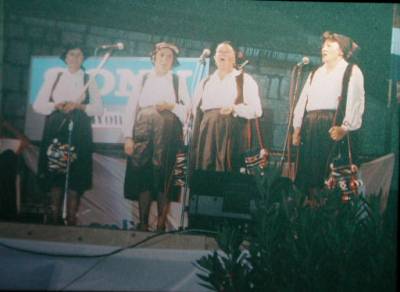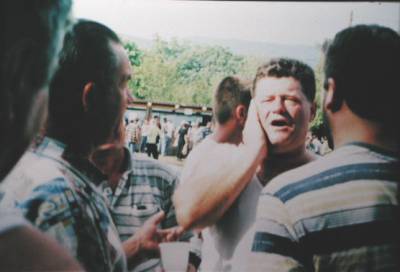| According to data collected from the available
literature, particularly travelogues, official reports
and ethnographic and ethnomusicological research, the
inhabitants of the region are not familiar with the term music
in the western sense of the word. The corresponding
terms they use are singing and playing which have
the same meaning as music. When making arrangements
between themselves about singing and when describing the
form, they use their own terminology to describe the role
of the singer - goni, vata, konta
[leading, catching, counting]; for dynamic - slaba
pisma [weak song] as opposed to jaka pisma [strong
song], rhythmic procedures - otegnuto pivanje [slow
singing], brzo pivanje [fast singing], as well as
the formal structure of the tune - duga [long](rera)
and kratka [short](rera). The melodies are based on limited tone sequences, largely chromatic, with intervals whose size does not correspond to present tempered system. A large number of vocal forms is polyphonic in structure, in a texture in which the major second interval dominates. Tunes often end in a major second perceived as a consonant interval. There are several styles and several music forms within them.
The song - that is, a vocal performance and vocal-instrumental singing to a gusle accompaniment dominates in relation to instrumental performances. Vocal performance is socially accepted by both genders , while instrumental performance as a rule is connected with men. Songs differ in texts but not in music form. Singing of a new text (in decasyllabic couplets) to the same or a similar music form is regarded as a new song. It is also possible to perform several times one and the same song (with the same text) with variation of the music form and the textual model, as well as the tone relations. This leads one to think that the function of the tones in relation to one another cannot be precisely explained as part of the enclosed music system, without reference to the structure of the pertaining social and cultural system (Blacking, 1974: 75). The concept of performance does not entail a process of prior practice and coordination. Each performance has just that character and it can be adjudged as being good or inferior (tanko [too thin], visje [high], ne slaze [out of sync]). Performance requires a certain attitude, position and order among the singers, many of whom cover one ear with their hand as they sing. The performance is evaluated by both singers and listeners, who usually concur in their opinions of the performance. Both groups aspire to a preconceived harmony, equally enjoying their particular functions - the singer is pleased to be able to enjoy his own singing, just as the listener does, who actively listens and evaluates the performance. One of the pre-conditions for a good performance is loud singing which requires certain physical effort, which is exceptionally pleasing to both singers and audience.
Loud and often incomprehensible singing in high registers reminds the "passive listener" (6) of plain noise. The parallel performance of several vocal and instrumental performances which are tolerated by both singers and listeners can also be described by outsiders as noise. The fact is that this singing invokes opposing reactions - from extremely pleasant to extremely unpleasant. To many urban-dwellers this singing is coarse and discordant, reminiscent of shouting and yelling, and in many instances it is not treated as music at all. Such an attitude towards this music creates (and is created by) a series of cultural stereotypes. The entrenched opinion is that everyone who lives or originates from this region knows how to sing in this way, that is, engages in this type of singing. The insults to which they are exposed because of their origins range from the verbal - with imitation of howling - to the visual - covering the ear and part of the face with the palm, in that way imitating the typical performance pose of the singers from the Dalmatian Hinterland . The overall stance of society was similar: it tried to neglect "these artifacts in order to replace them with 'more cultivated' patterns of interpretation of national music, composing new forms in an 'elaborated' way" (Petrovic, 1995: 61). |

